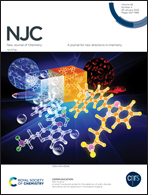Discovery of a highly selective and ultra-sensitive colorimetric fluorescent probe for malononitrile and its applications in living cells and zebrafish†
Abstract
As a highly toxic organic compound, malononitrile can cause serious harm to human health and environment. However, methods for the rapid detection of malononitrile are rarely reported. Hence, this study provides a convenient and effective method for the detection of malononitrile using cinnamaldehyde compounds as a fluorescent probe DC-Mal. The fluorescence intensity of the probe has excellent linearity with the concentration of malononitrile, and the detection limit is as low as 18 nM. In addition, the probe has good selectivity and anti-interference, and only has good recognition effect on malononitrile. The color of the probe changed from light green to light pink for naked eye observation after the reaction. Most importantly, the probe can be used for the biological imaging of living cells and zebrafish. These results indicate that the probe can be used for the detection of malononitrile in organisms and environment.



 Please wait while we load your content...
Please wait while we load your content...